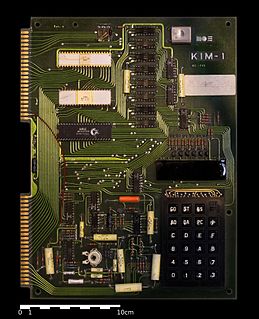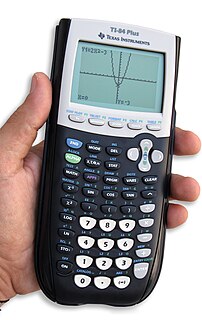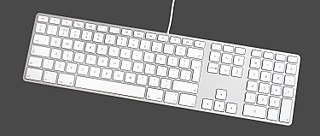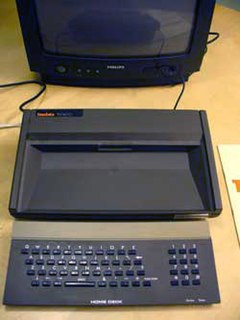Related Research Articles
Instructional design (ID), also known as instructional systems design (ISD), is the practice of systematically designing, developing and delivering instructional materials and experiences, both digital and physical, in a consistent and reliable fashion toward an efficient, effective, appealing, engaging and inspiring acquisition of knowledge. The process consists broadly of determining the state and needs of the learner, defining the end goal of instruction, and creating some "intervention" to assist in the transition. The outcome of this instruction may be directly observable and scientifically measured or completely hidden and assumed. There are many instructional design models but many are based on the ADDIE model with the five phases: analysis, design, development, implementation, and evaluation.

The KIM-1, short for Keyboard Input Monitor, is a small 6502-based single-board computer developed and produced by MOS Technology, Inc. and launched in 1976. It was very successful in that period, due to its low price and easy-access expandability.
Adobe Authorware was an elearning authoring tool with its own interpreted, flowchart-based, graphical programming language. Authorware was used for creating interactive elearning programs that could integrate a range of multimedia content, particularly electronic educational technology applications. The flowchart model differentiated Authorware from other authoring tools, such as Adobe Flash and Adobe Director, which rely on a visual stage, time-line and script structure.
Educational software is a term used for any computer software which is made for an educational purpose. It encompasses different ranges from language learning software to classroom management software to reference software. The purpose of all this software is to make some part of education more effective and efficient.

A graphing calculator is a handheld computer that is capable of plotting graphs, solving simultaneous equations, and performing other tasks with variables. Most popular graphing calculators are also programmable and therefore considered to be programmable calculators, allowing the user to create customized programs, typically for scientific, engineering and education applications. Because they have large displays in comparison to standard four-operation handheld calculators, graphing calculators also typically display several lines of text and calculations at the same time.

PLATO was the first generalized computer-assisted instruction system. Starting in 1960, it ran on the University of Illinois' ILLIAC I computer. By the late 1970s, it supported several thousand graphics terminals distributed worldwide, running on nearly a dozen different networked mainframe computers. Many modern concepts in multi-user computing were originally developed on PLATO, including forums, message boards, online testing, e-mail, chat rooms, picture languages, instant messaging, remote screen sharing, and multiplayer video games.

The Acorn System 1, initially called the Acorn Microcomputer (Micro-Computer), was an early 8-bit microcomputer for hobbyists, based on the MOS 6502 CPU, and produced by British company Acorn Computers from 1979.

Apple Inc. has designed and released dozens of keyboard models since the introduction of the Apple II in 1977. The current models in use are dual-mode keyboards with integrated batteries: Magic Keyboard, and Magic Keyboard with Numeric Keypad. Both share a similar look and feel, based on a very thin aluminum chassis and laptop-style low-profile keys, sitting much closer to the tabletop than traditional keyboard designs.
An intelligent tutoring system (ITS) is a computer system that aims to provide immediate and customized instruction or feedback to learners, usually without requiring intervention from a human teacher. ITSs have the common goal of enabling learning in a meaningful and effective manner by using a variety of computing technologies. There are many examples of ITSs being used in both formal education and professional settings in which they have demonstrated their capabilities and limitations. There is a close relationship between intelligent tutoring, cognitive learning theories and design; and there is ongoing research to improve the effectiveness of ITS. An ITS typically aims to replicate the demonstrated benefits of one-to-one, personalized tutoring, in contexts where students would otherwise have access to one-to-many instruction from a single teacher, or no teacher at all. ITSs are often designed with the goal of providing access to high quality education to each and every student.
An authoring system is a program that has pre-programmed elements for the development of interactive multimedia software titles. Authoring systems can be defined as software that allows its user to create multimedia applications for manipulating multimedia objects.
Learning pathway is described as the chosen route taken by a learner through a range of (commonly) e-learning activities, which allows them to build knowledge progressively. With learning pathways, the control of choice moves away from the tutor to the learner. "The sequence of intermediate steps from preconceptions to target model form what Scott (1991) and Niedderer and Goldberg (1995) have called a learning pathway. For any particular topic, such a pathway would provide both a theory of instruction and a guideline for teachers and curriculum developers".
Interactive courseware aids learners to access information and tools by which they can construct personalized transitions between the information to be accessed and their own cognitive structures. The process of navigation enables learners to experience the content of interactive courseware. Learning pathways also reveal the learning trails while learners traverse any interactive environment. Since learners have unique knowledge structures based upon their experiences and abilities, the ways that they choose to access, interact, and interrelate messages in interactive courseware also vary. Studies on pathways help us to explore and explain human behaviors during learning processes.
In the context of e-learning, interactivity is defined as "the function of input required by the learner while responding to the computer, the analysis of those responses by the computer, and the nature of the action by the computer."
The VideoBrain Family Computer is an 8-bit home computer manufactured by Umtech Incorporated, starting in 1977. It is based on the Fairchild Semiconductor F8 CPU. It was not a large commercial success and was discontinued from the market less than three years after its initial release. Some of its lack of success has been attributed to the decision to substitute the APL/S programming language over the then-standard BASIC. Due to the high cost of RAM memory, it only contained 1 KB. It had a full-travel keyboard, unlike some early home computers that featured membrane keypads, but with a very non-standard layout. It was designed by David Chung and Albert Yu.

A cable converter box or television converter box is an electronic tuning device that transposes/converts channels from a cable television service to an analog RF signal on a single channel, usually VHF channel 3 or 4, or to a different output for digital televisions such as HDMI.
Each time Intel launched a new microprocessor, they simultaneously provided a System Development Kit (SDK) allowing engineers, university students, and others to familiarise themselves with the new processor's concepts and features. The SDK single-board computers allowed the user to enter object code from a keyboard or upload it through a communication port, and then test run the code. The SDK boards provided a system monitor ROM to operate the keyboard and other interfaces. Kits varied in their specific features but generally offered optional memory and interface configurations, a serial terminal link, audio cassette storage, and EPROM program memory. Intel's Intellec development system could download code to the SDK boards.

A virtual learning environment (VLE) is a system that creates an environment designed to facilitate teachers' management of educational courses for their students, especially a system using computer hardware and software, which involves distance learning. In North America, a virtual learning environment is often referred to as a "learning management system" (LMS).

M. David Merrill is an education researcher specializing in instructional design and technology.
Andrew S. Gibbons is a practitioner and theorist in the field of Instructional Design and Technology. He has proposed an architectural theory of instructional design influenced by the structural principles of artifact modularization drawn from a number of design disciplines, as exemplified by the work of Baldwin and Clark.

The Casio Algebra FX series was a line of graphing calculators manufactured by Casio Computer Co., Ltd from 1999 to 2003. They were the successor models to the CFX-9970G, the first Casio calculator with computer algebra system, or CAS, a program for symbolic manipulation of mathematical expressions. The calculators were discontinued and succeeded by the Casio ClassPad 300 in 2003.
The Hazeltine 2000 is one of the first general-purpose "smart" computer terminals, introduced in October 1970 at a price of $2,995. While earlier terminal systems included "smart" editing features, notably the IBM 2260, the Hazeltine 2000 was the first that used a standard RS-232 interface and sent its control sequences in the data stream. It could be attached to any contemporary minicomputer or mainframe that had a serial port and used ASCII-standard character sets.
References
- 1 2 "TICCIT: Building Theory for Practical Purposes". International Journal of Designs for Learning. 5 (2): 1–19. Nov 3, 2014.
- ↑ Merrill, M. D., Fletcher, K., & Schneider, E. (1980). Ticcit (The Instructional Design Library, v. 40). Englewood Cliffs, NJ: Educational Technology Publications. p. 72. ISBN 0-87778-160-5.
{{cite book}}: CS1 maint: multiple names: authors list (link) - ↑ "Helping hand for the handicapped" (PDF). Measure: 16. March 1976.
- ↑ Upton, Molly (August 8, 1977). "Handicapped Kids Learn at Home Via Cable TV". Computerworld: 9.